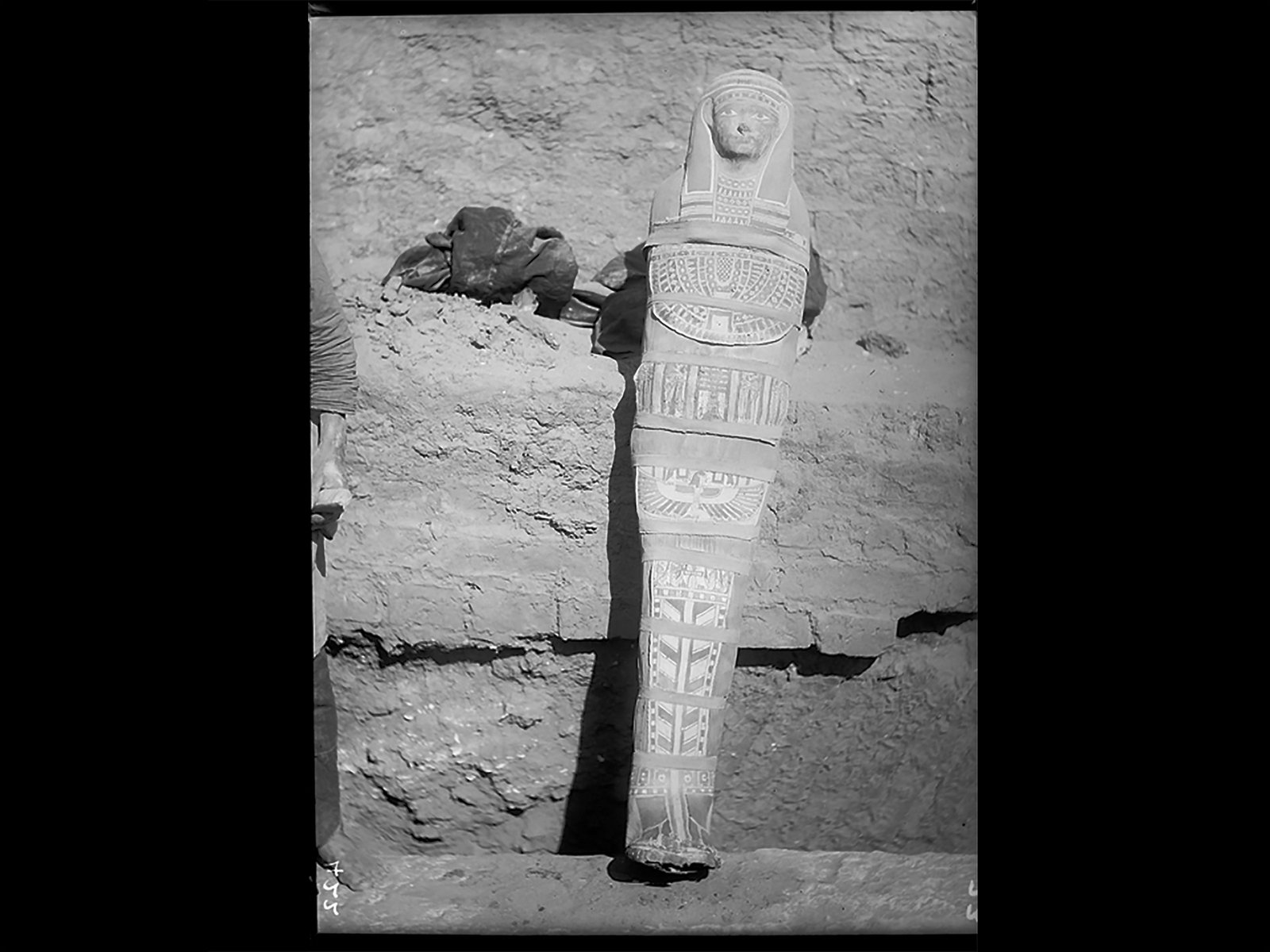Funerary mask from Abydos - 4th century BCE
On this page...
Egyptian burial practices evolved through millennia. The Ptolemaic Period (332-30 BCE) – the last stage of the ancient kingdom - saw a distinct form and proliferation of cartonnage body masks.
Mummified bodies were typically fitted with six pieces of cartonnage – an ancient kind of papier mâché, made by layering a cloth or papyrus with adhesive and plaster before painting. These body masks could trace their origin to elaborately painted full-body cartonnage cases of the Third Intermediate Period (c. 1077 - 664 BCE) but were easier and cheaper to produce.
Scholars observed their wide use at the time Egypt was in Greek hands – from Ptolemy I and his successors, down to Cleopatra VII (70/69 - 30 BCE) – a legendary and tragic last ruler of Ancient Egypt.
Drag to reveal cartonnage over original image


Colour Egyptian cartonnage mask set mapped over top of original black and white glass plate photo taken at dig site. Image: Courtesy of the Griffith Institute. Attributed to the Ptolemaic period (332-30 BCE) - calibrated radiocarbon date c. 350 BCE. Acquired in 1912 through the Egypt Exploration Fund. Registration number: E021583
The Australian Museum acquired a set of cartonnage body masks from Abydos via subscription to the Egypt Exploration Fund in 1912. This mask (E021583) is from tomb 422, opened and researched in 1911-12 by Thomas Eric Peet, a young archaeologist and future academic at the University of Oxford - advocating for more rigorous methods in Egyptian archaeology.
The tomb 422 (cemetery “E” in Abydos) was known at that time as the only sepulchre not ransacked and looted, as many burials were, possibly even in antiquity. Peet described it relatively well in his report (The Cemeteries of Abydos) providing an important context that can help to better understand the masks and their use.
The tomb contained seven large limestone coffins with fully mummified adults with cartonnage body masks and five mummified children – only one child had a cartonnage mask. It appears many bodies were not well preserved, but some complete mummies and some mask sets were distributed to various subscribers – an unfortunate practice of splitting burial contents – including the Carnegie Institute in Pittsburgh, the Yale Peabody Museum of Natural History, and the British Museum.
It would be interesting to know if and how all twelve people in tomb 422 were related. But the masks indicate some hierarchy of means and perhaps emotional bonds as could be inferred from one gold leaf mask and one child equipped with a body mask – not a common custom - with a headpiece of adult size.
A cartonnage body mask typically consists of six pieces fitted in a set order.
The headpiece known as a helmet mask covers the sides and back of the head. More than protect, it was to elevate the deceased to a divine status. The idealised painted face was to promote association with the gods. No name of a person was inscribed on this mask. [E021583-005]
On the upper chest a broad collar was placed, depicting a winged sun disc flanked by two falcon heads on top and a shrine suspended in the middle. [E021583-001]
On the abdomen was a rectangular piece depicting the four Sons of Horus separated by columns and in the canter a djed pillar - the symbolic backbone of the god Osiris indicating stability. [E021583-003]
Just under the abdomen was a rectangular piece showing a seated winged goddess. [E021583-002]
The leg piece represents an openwork flanked by floral motifs and a row of guardian deities holding knives at the top. [E021583-004]
A three-dimensional foot cover shows two feet in sandals with the top and base decorated with lotus flowers. [E021583-006]
The cartonnage body mask illustrates the last stage of ancient Egyptian burial customs. After the demise of Cleopatra’s kingdom - she killed herself in 30 BCE - it became a province of the Roman empire – burial practices evolved into interesting eclectic forms. Old-style mummification continued but the form and symbolism of body preparation were altered whereby the realistic portrait painted on a flat board was placed on the mummy’s “face”. Known as Fayum portraits these boards are frequently of high artistic and aesthetic quality and they influenced Byzantine art with its distinct icons.
Explore 3D model of the Egyptian funerary mask
Reference:
- Thomas Eric Peet. 1914. The Cemeteries of Abydos Part II. 1911-1912. London: Egypt Exploration Fund.
Explanation:
- BCE (or BC) – means Before Common Era, and indicates the years counted back from the first year of the Western Calendar. For example, in 30 BCE Rome conquered Egypt.







